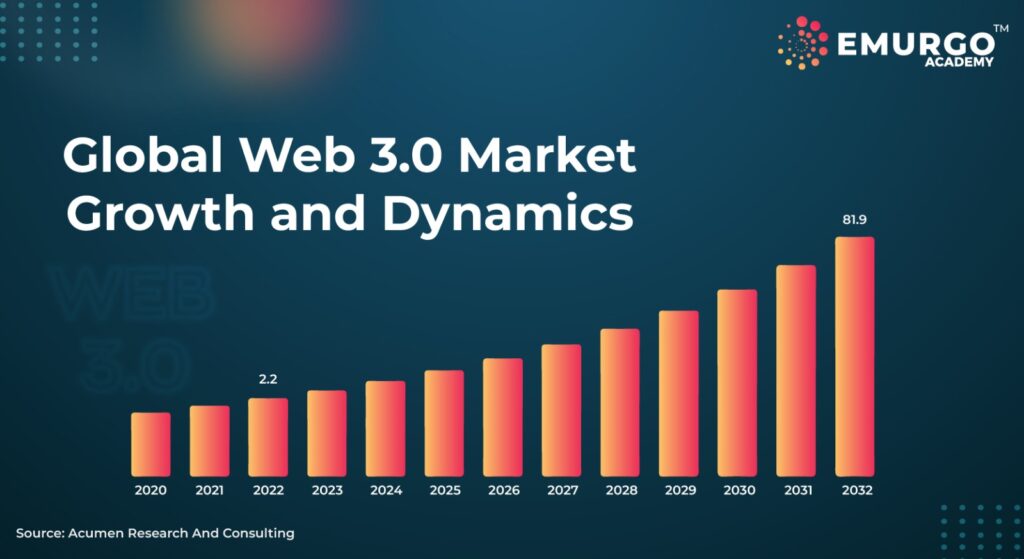The internet has undergone significant transformations since its inception, and Web 3.0 is the next evolution in this ongoing process. Often referred to as the decentralized web, Web 3.0 promises a new era of innovation, privacy, and user empowerment.
In this comprehensive guide, we will explore what Web 3.0 is, its key features, and its potential impact on various aspects of our digital lives.
What is Web 3.0?
Web 3.0 represents a paradigm shift from the centralized model of Web 2.0 to a more decentralized and user-centric approach. Unlike Web 2.0, which relies heavily on centralized platforms and service providers, Web 3.0 leverages blockchain technology and decentralized protocols to create a more open, transparent, and secure internet.
To understand Web 3.0, let’s consider an example:
Imagine you want to sell a digital artwork that you created. In the traditional Web 2.0 model, you would typically need to rely on a centralized platform, such as an online marketplace or social media platform, to showcase and sell your artwork. These platforms act as intermediaries, controlling the transactions, fees, and even the visibility of your artwork.
Now, in the Web 3.0 world, things work differently. Instead of relying on a centralized platform, you can utilize a decentralized marketplace powered by blockchain technology. Here’s how it works:
Ownership and Authenticity: You can create a unique digital token representing your artwork, called a non-fungible token (NFT). This NFT serves as a digital certificate of ownership and authenticity, ensuring that your artwork is unique and cannot be replicated or tampered with.
Direct Peer-to-Peer Transactions: Using a decentralized marketplace built on Web 3.0 principles, you can directly connect with potential buyers without intermediaries. Smart contracts facilitate secure and transparent transactions, eliminating the need for middlemen and reducing transaction fees.
Transparent and Immutable Records: Every transaction and ownership transfer is recorded on the blockchain, creating a permanent and transparent record of your artwork’s history. This transparency builds trust and ensures the integrity of the transaction.
Important Statistics on Web 3.0
The market analysis of Web 3.0 indicates a promising growth outlook with a Compound Annual Growth Rate (CAGR) of 44.5%, potentially reaching a market capitalization of USD 81.9 billion by the year 2032.
From 2023 to 2032, the Asia-Pacific region is anticipated to witness substantial expansion in the Web 3.0 market, with a projected Compound Annual Growth Rate (CAGR) of approximately 47%.

By embracing Web 3.0, you, as the artist, have greater control over your work, can engage directly with buyers, and benefit from secure and transparent transactions.
This example illustrates how Web 3.0 aims to empower individuals, foster innovation, and reshape various aspects of our digital interactions by removing unnecessary intermediaries and enabling trustless, peer-to-peer interactions.
Key Features of Web 3.0
Web 3.0 introduces several key features that form the foundation of the decentralized web. Let’s dive deeper into each feature to understand how they contribute to a more open, secure, and user-centric internet.
- Decentralization
Web 3.0 aims to reduce the influence and control of centralized authorities by distributing power and decision-making across a network of participants. Blockchain technology plays a crucial role in this decentralization process, enabling trustless interactions and removing the need for intermediaries.
- Interoperability
Web 3.0 strives to create an interconnected digital ecosystem where different applications and platforms can seamlessly interact and share data. This interoperability fosters innovation and allows users to have greater control over their personal information.
- Data Ownership and Privacy
Web 3.0 shifts the ownership of data from centralized entities to individual users. With self-sovereign identity and encrypted data storage, users can have full control over their personal information, choosing when and how it is shared.
- Smart Contracts and Decentralized Applications (DApps)
Web 3.0 leverages smart contracts, which are like self-executing agreements written in code, to automate processes and eliminate the need for intermediaries. DApps, powered by blockchain technology, offer new possibilities for decentralized services, ranging from finance and governance to gaming and social media.
Impact on Various Sectors
Web 3.0 has the potential to revolutionize several industries:
- Finance
Decentralized finance (DeFi) applications built on Web 3.0 can provide financial services without intermediaries, enabling borderless and inclusive access to banking, lending, and investments.
- Healthcare
Web 3.0 can empower individuals to securely store and control their health records while facilitating secure data sharing between healthcare providers. It also opens avenues for decentralized research and development.
- Supply Chain
With increased transparency and traceability, Web 3.0 can enhance supply chain management, reducing fraud, counterfeiting, and ensuring ethical sourcing.
- Education
Web 3.0 enables decentralized learning platforms, credential verification, and peer-to-peer collaboration, transforming traditional educational models.
- Impact on Governance
Web 3.0 has the potential to transform governance systems by introducing greater transparency, accountability, and citizen participation. Decentralized governance models built on blockchain technology can enable direct voting, decentralized decision-making, and verifiable records, reducing the potential for corruption and manipulation
Conclusion
Web 3.0 represents a paradigm shift towards a more decentralized, user-centric internet, offering improved privacy, security, and data ownership. By leveraging blockchain technology, interoperability, and smart contracts, Web 3.0 has the potential to revolutionize various industries and empower individuals.
As the decentralized web continues to evolve, it is essential for individuals to stay informed and participate actively in shaping this new era of the internet, fostering innovation, and realizing the true potential of a user-centric digital world.

